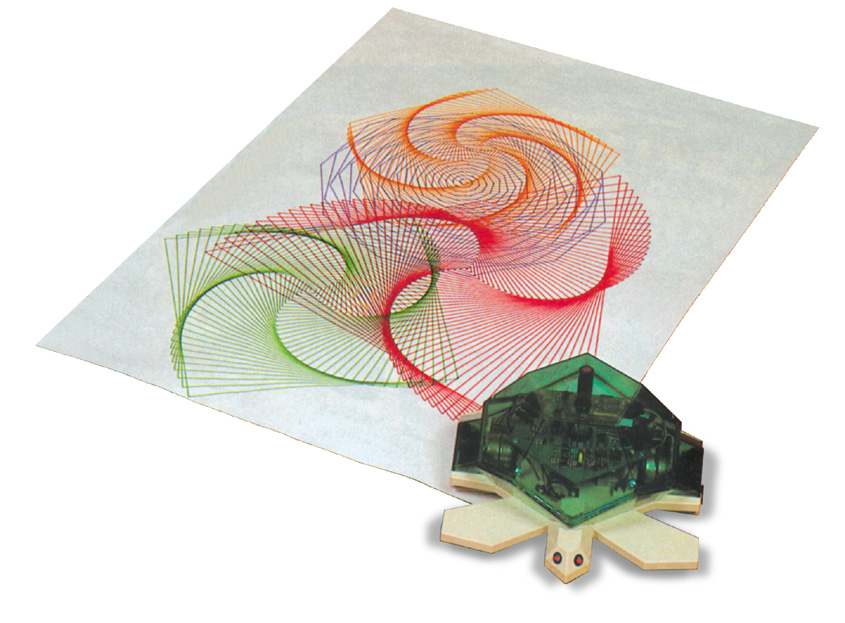Turtle Robot on:
[Wikipedia]
[Google]
[Amazon]
 Turtles are a class of educational robots designed originally in the late 1940s (largely under the auspices of researcher William Grey Walter) and used in computer science and mechanical engineering training. These devices are traditionally built low to the ground with a roughly hemispheric (sometimes transparent) shell and a power train capable of a very small turning radius. The robots are often equipped with
Turtles are a class of educational robots designed originally in the late 1940s (largely under the auspices of researcher William Grey Walter) and used in computer science and mechanical engineering training. These devices are traditionally built low to the ground with a roughly hemispheric (sometimes transparent) shell and a power train capable of a very small turning radius. The robots are often equipped with LOGO Frequently asked Questions (FAQ): What was the genesis of Logo?
University of Hamburg, archived March 10, 2009 fro
/ref> "Irving" contained bump sensors and could give audio feedback with a bell. The development of the robotic Logo turtle led to the use of the term to describe the cursor in video screen implementations of the language and its turtle graphics package.
The Story of Turtle Robots in Pictures.Articles about Turtle and Roamer robots.Photo gallery of Walter's original turtles and a Lego-based replica
about early UK
A Logo Primer or Whats with the Turtles
Logo Foundation. Historical robots Hobbyist robots Educational robots 1940s robots Robots of the United States Three-wheeled robots
 Turtles are a class of educational robots designed originally in the late 1940s (largely under the auspices of researcher William Grey Walter) and used in computer science and mechanical engineering training. These devices are traditionally built low to the ground with a roughly hemispheric (sometimes transparent) shell and a power train capable of a very small turning radius. The robots are often equipped with
Turtles are a class of educational robots designed originally in the late 1940s (largely under the auspices of researcher William Grey Walter) and used in computer science and mechanical engineering training. These devices are traditionally built low to the ground with a roughly hemispheric (sometimes transparent) shell and a power train capable of a very small turning radius. The robots are often equipped with sensor
A sensor is a device that produces an output signal for the purpose of sensing a physical phenomenon.
In the broadest definition, a sensor is a device, module, machine, or subsystem that detects events or changes in its environment and sends ...
devices which aid in avoiding obstacles and, if the robot is sufficiently sophisticated, allow it some perception of its environment. Turtle robots are commercially available and are common projects for robotics hobbyists.
Turtle robots are closely associated with the work of Seymour Papert and the common use of the Logo programming language in computer education of the 1980s. Turtles specifically designed for use with Logo systems often come with pen mechanisms allowing the programmer to create a design on a large sheet of paper. The original Logo turtle, built by Paul Wexelblat at BBN, was named "Irving" and was demonstrated at the former Muzzey Junior High in Lexington, Massachusetts.University of Hamburg, archived March 10, 2009 fro
/ref> "Irving" contained bump sensors and could give audio feedback with a bell. The development of the robotic Logo turtle led to the use of the term to describe the cursor in video screen implementations of the language and its turtle graphics package.
See also
* BEAM robotics, the branch of robotics pioneered in part by William Grey Walter {{Citation needed, reason=I'd go with Mark Tilden here., date=February 2022, specializing in autonomous devices using simple analog control systems *iRobot Create
iRobot Create is a hobbyist robot manufactured by iRobot that was introduced in 2007 and based on their Roomba vacuum cleaning platform. The iRobot Create is explicitly designed for robotics development and improves the experience beyond simply ...
and its predecessor Roomba
Roomba is a series of autonomous robotic vacuum cleaners made by the company iRobot. Introduced in September 2002, they have a set of sensors that enable them to navigate the floor area of a home. These sensors can detect the presence of obstac ...
, turtle-like robots originally designed for domestic use
* Player Project, a free robotics suite.
* Curses (computer game)
''Curses'' is an interactive fiction computer game created by Graham Nelson in 1993. Appearing in the beginning of the non-commercial era of interactive fiction, it is considered one of the milestones of the genre.
Writing for ''The New York T ...
, an interactive fiction
''
Interactive fiction, often abbreviated IF, is software simulating environments in which players use text commands to control characters and influence the environment. Works in this form can be understood as literary narratives, either in the ...
game by Graham Nelson that includes a voice-operated turtle in one of its more difficult puzzles
* Unicycle cart, for a mathematical model of the dynamics of a turtle robot
References
External links
The Story of Turtle Robots in Pictures.
about early UK
analog
Analog or analogue may refer to:
Computing and electronics
* Analog signal, in which information is encoded in a continuous variable
** Analog device, an apparatus that operates on analog signals
*** Analog electronics, circuits which use analo ...
turtle designs from the Bristol Robotics LaboratoryA Logo Primer or Whats with the Turtles
Logo Foundation. Historical robots Hobbyist robots Educational robots 1940s robots Robots of the United States Three-wheeled robots